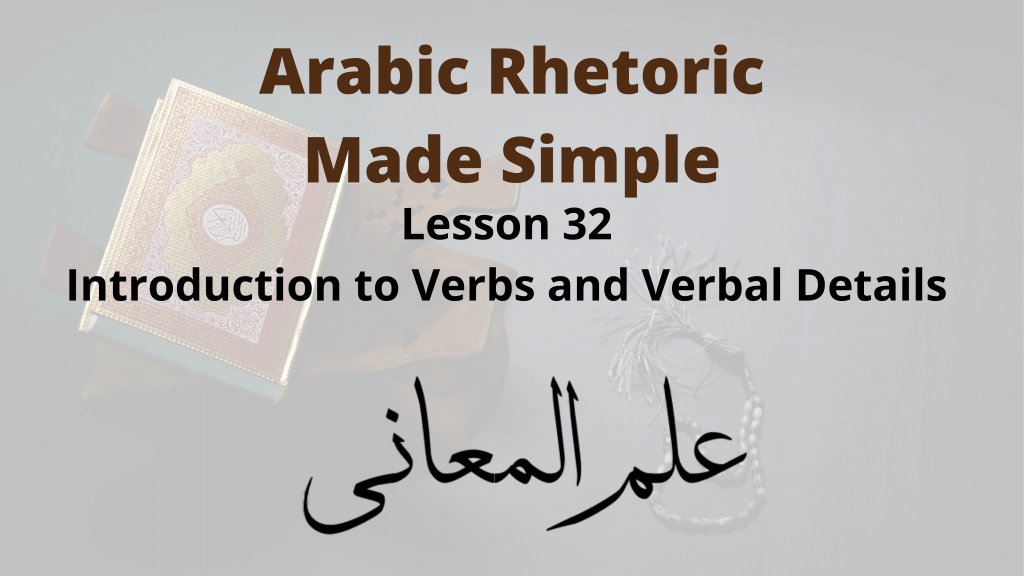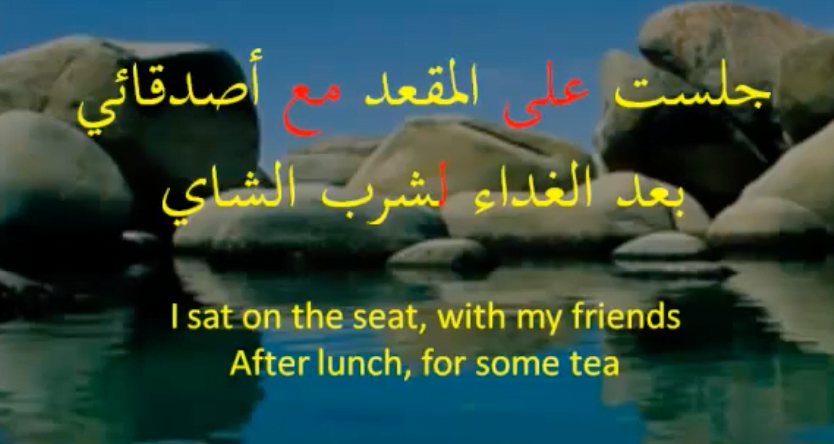In this lesson on Balagha, we are going to move onto a new chapter in ilm ul ma’aani about verbs and verbal details.

In the first chapter of ilm ul ma’aani, we looked at the sentence as a whole. We learned the motives behind the sentence, it being literal or figurative, adding emphasis and so on.
Then we focused on the subject, and we talked about whether we should omit it or mention it. Whether it should be definite or indefinite. How we should express it. Where we should place it and so on.
Then we focused on the predicate. We learned about omitting and mentioning it. The various forms it can take. Where it can appear in a sentence, etc.
Somewhere along the way we even skipped ahead and covered the chapter on conjunction of multiple sentences. When it is allowed, when it is not allowed and so on.
Table of Contents
Parts of a Verbal Sentence
In this lesson we start taking a closer look at the inner workings of a verbal sentence, and the relationship between a verb and its various details. Such as objects, adverbs and prepositional phrases.

As you can tell the science of ilm ul ma’aani is very systematic. First we look at the sentence as a whole, then we focus on the various parts of the sentence; subject, predicate, verbal details. Then we look at how sentences come together in conjunction.
In the future chapters we are going to take a look at the use of non-informative sentence within our discourse. We are also going to look at brevity and lengthiness. Finally there is a specific chapter in ilm ul ma’aani that deals with restriction, in our discourse.
For now, we are talking about verbs and verbal details.
Verbal Subject
As you know, every verb has a subject.
Whether that subject is mentioned explicitly after the verb:

Whether it is mentioned as a pronoun attached to the verb:

Or whether it is a pronoun hidden within the verb:

Then after the verb and its subject we can have further details about the verb; where did it happen, when did it happen, why, for how long, under what circumstances. We can just keep adding more and more details to our hearts content.
Verbal Details Beyond the Subject
There are three ways of adding details to a verb.
Via Prepositional Phrases
The first is through the use of prepositional phrases.
You can utilize dozens of prepositions in the Arabic language to introduce further information about the verb.

For example: I sat on the seat, with my friends, after lunch, for some tea.
Notice we can just keep using more and more prepositions to give more and more information about the action of sitting. On what? With whom? After what? For what purpose? And so on.
Via Adverbs
The second way of adding details to a verb is through the use of adverbs.
In Arabic, adverbs are nothing more than some very common prepositional phrases without the preposition itself. Because these details are so common in everyday discourse, the preposition is dropped and the detail gets promoted to the level of adverb. Since there is no preposition to make the word majroor anymore, it reverts to being mansoob.
For example: I sat quietly.
The manner in which you sit is apparently so important and common in everyday speech that you don’t have to say “I sat in quiet”. Instead you can promote this detail to the level of adverb and simply say “I sat quietly”.
In Arabic, the details that can be promoted from the level of prepositional phrase to the level of adverb are 7 in number.

مفعول فيه tells you when and/or where the verb happened.
مفعول له tells you why it happened.
مفعول معه tells you tantamount to what did it happen.
مفعول مطلق gives you the opportunity to turn the verb into a noun, to which you can add any number of descriptions that you otherwise wouldn’t be able to if it was in the verbal form. Hence the term مطلق, meaning “general”.
There are 3 others. All of these are covered in great detail in grammar. Consult the tutorial entitled Arabic Adverbs.
Via Direct Objects
The third and final way to add details to a verb is through the use of objects. Objects are even more special than adverbs.
Sometimes one of the details of your verb is so important that it gets promoted from the level of a prepositional phrase, not just to the level of adverb, but to the level of direct object. Not only is there no preposition before it, but direct objects actually become part of the nature or definition of a verb.
For example, the verb “to eat”. When you eat, you eat something. That something is expressed as the direct object of “eating”, because when it comes to eating, the thing that you eat is so important. It is too important to be left among the prepositional phrases or even among the adverbs. It is too special. It has to be mentioned as a direct object. Of course this differs between languages and cultures. There might be a culture in which the thing that you eat is introduced by a preposition. Or there might be a language in which when you talk about sitting, the thing that you sit on is very significant and is introduced as a direct object. For example: “I sat the chair”.
As you can see, unlike adverbs and prepositional phrases, objects are part of the nature of a verb.
For example, we know that the verb “to eat” in English and in Arabic takes a direct object, which is the thing that you eat. And we know that the verb “to sit” in English and in Arabic takes no direct object. Whether a verb takes a direct object or not, and how many it takes is part of the specific verb. You look it up in the dictionary. Unlike adverbs and prepositional phrases, you can add these or remove these at will to any verb.
Verbs that don’t have direct objects at all are called intransitive verbs.

Verbs that do are called transitive verbs.

Some verbs have two objects, for example the Arabic verb عَلِمْتُ.

Here the thing you knew about and what you knew about it are both introduced as direct objects.
Some verbs actually have 3 objects. These are quite rare, but they are there. For example أَعْلَمْتُ:

When it comes to doing I’laam in Arabic, the person you make come to know, the thing you make them come to know about and the fact that you make them come to know are all objects of the verb.
In our study of verbs and verbal details we are going to address three issues.
Omitting an object
The first is omitting the object of a verb.

Remember that the adverbs and prepositional phrases are not part of the nature of a verb. We can add and remove them at will to any verb, to give more or less information about that verb/action. But objects are indeed part of the nature of a verb. So when a particular verb takes an object by nature and then you go ahead and you omit that object, you better have a good reason for doing that. So we are going to look at why.
Advancing a Detail Before the Verb
The second issue we are going to address is moving a detail of the verb to before the verb.

We have moved the object of the verb نَسْتَعِينُ to in front of the verb. This is actually a very important topic in balagha.
Rearranging Details
The third issue we are going to address is the ordering of verbal details among each other. So they are coming after the verb, but among each other, what is the order supposed to be. As you know the natural order is: the verb, then the subject, then the objects, then the adverbs, then the prepositional phrases. But sometimes the relative order of these things can be jumbled around.

These are the three issues we are going to look at in this chapter of ilm ul ma’aani.
- Proceed to next lesson: Omitting the Direct Object
- Return to index page: Intro to Ilm Ul-Ma’ani
- Start free lessons: Sign Up for Free Mini-class